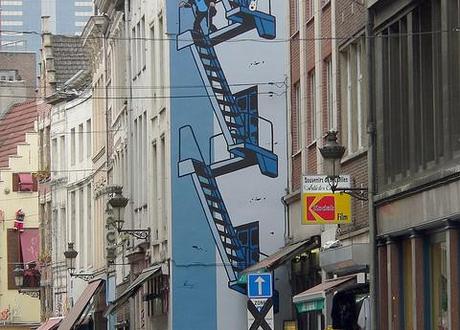
Tintin is alive in this life-size mural on the Rue D'Etuves in Brussels, Belgium. With Spielberg's film, audiences can now see him in CGI. Photo Credit: sinanyuzakli http://www.flickr.com/photos/sinanyuzakli/4404286474/sizes/z/in/photostream/
Spielberg’s eagerly anticipated performance capture 3D interpretation of The Adventures of Tintin has failed to dazzle the UK critics but it’s been warmly received over the Atlantic.
The film’s heroes are, of course, the earnest boy-journalist-cum-hero Tintin (Jamie Bell) and his dog Snowy, who we know from their adventures in Belgian author Hergé’s era-defining comic books. All the regulars are here too: the perma-sozzled Captain Haddock (Andy Serkis), the bumbling detectives Thompson and Thompson (Nick Frost and Simon Pegg) and bad guy Red Rakham (Daniel Craig), though the latter is now reincarnated as an equally devious Ivanovich Sakharine. But the film is not for purists: the film’s plot, a fusion of The Secret of the Unicorn with The Crab With the Golden Claws and a hint of Red Rackham’s Treasure was cobbled together by British authors Joe Cornish, Steven Moffat and Edgar Wright, and tries to squeeze in as much action as possible. In it, the young Tintin mistakenly buys a model of a ship from a flea-market, precipitating a rip-roaring sequence of adventures that never stops, from his (undefined) Western European city home to the fictional Moroccan city of Bagghar and back again.
So far, so fun, and with a one-shot chase scene through the streets of Bagghar and a dream sequence in which the Unicorn galleon is transported across the desert on a giant wave, the film should be a knockout, right? Well, American critics love it, while their UK counterparts are not so sure. Here’s what they have to say:
Lifeless CGI leaves details “sorely wanting.” Tintin has finally become the statue the villains of Hergé’s last unfinished comic Tintin and the Alph-Art promised he’d be. “How curious that Hergé achieved more expression with his use of ink-spot eyes and humble line drawings than a bank of computers and an army of animators were able to achieve”, remarked Xan Brooks of The Guardian. Though Brooks had all kinds of praise for the “set pieces”, he hated the animation, which he said leaves the audience feeling like they’re “partying with ghosts.”
The graphics and a “misjudged” script make for a lacklustre film. At The Daily Telegraph, Robbie Collin also disliked the CGI rendering of Hergé’s classic. There’s a “mechanistic quality to Spielberg’s craft that’s undoubtedly disappointing”, sniped Collin, who lamented that the director did not lend his distinctive touch to it. Indeed, he said, the film feels like “it could have been made by anyone”.
Stylish and charming. On the other side of the Atlantic, Leslie Felperin of Variety magazine loved the new Tintin. “Charmingly stylized and cartoony”, she gushed, adding that the film has been animated with “immense sensitivity.”
European charm brought to US screens. Wow! screamed Jordan Mintzer of The Hollywood Reporter, who praising the film from the roof-tops. Adjectives like “splendid” in the first sentence sum up this review, which spent a great deal of time trying to explain why Tintin matters to our US cousins.
More on film
- The Avengers trailer hits the web
- Lack of driving in Ryan Gosling-starring Drive prompts Michigan woman to sue
- Steve Jobs biopic in the pipeline as Sony acquire film rights to upcoming biography
- Human Centipede 2 world premieres
- Johnny English returns
- The Big Year: Big on birds, heart

